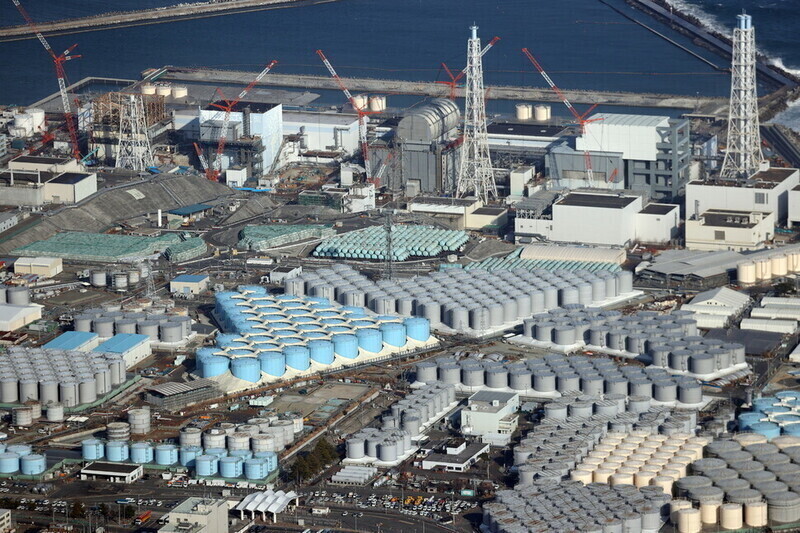hankyoreh
Links to other country sites 다른 나라 사이트 링크
Japan to dump another 54,600 tons of irradiated Fukushima water into sea this year

Since Aug. 24, 2023, Japan’s Tokyo Electric Power Company (TEPCO) has released three batches of radioactive water from storage tanks at the Fukushima Daiichi nuclear power plant for a total of 23,400 metric tons of water. The fourth batch of 7,800 tons is planned for the end of this month.
TEPCO intends to dump a total of 54,600 metric tons of contaminated water into the ocean from April 2024 to March 2025 in seven batches altogether.
The radioactive water is being decontaminated through the Advanced Liquid Processing System (ALPS), mixed with seawater to lower its radioactivity levels and then poured into the ocean near the damaged power plant through a 1-km-long underwater tunnel.
Since the power plant’s decommissioning has been delayed, 90 more tons of water are being contaminated each day, which leaves Japan struggling to fill what amounts to a bottomless pit. While Japan has managed to empty around 30 tanks by releasing contaminated water into the ocean, 20 more tanks have been filled during that process, so the total reduction thus far amounts to 10 storage tanks.
Another source of controversy is the safety of the dumping process. The International Atomic Energy Agency, which is monitoring the site of the Fukushima reactor, said there were no safety issues in a report released on Jan. 30 and that the release continued to conform to international standards.
But many inadequacies remain. To confirm the safety of the release, scientists from several countries ought to be allowed to take a range of samples to analyze changes in the radioactivity levels, but Japan has refused to allow that. President Yoon Suk-yeol of South Korea, who has otherwise condoned the release of contaminated water into the ocean, has asked that Korean experts be allowed to stay at the reactor on a continuing basis. But Japan is only letting those experts make regular visits.
In short, the current verification process depends on data from samples that were collected and analyzed by Japanese scientists.
There have been accidents, too. Last October, two workers cleaning the ALPS equipment were exposed to radiation when they were sprayed with wastewater. And on Feb. 7, around 1.5 tons of contaminated water had leaked from the facilities.
In Japan, fishers and seafood processors continue to request compensation for damage caused by harmful rumors, including the Chinese government’s decision to ban imports of Japanese seafood, with 130 such requests made as of last December.
The Japanese government has established a fund of 80 billion yen to deal with domestic losses, and TEPCO is providing substantial amounts of compensation. However, people in neighboring countries, including Koreans who depend on the sea for their livelihoods, are not eligible for such compensation.
By Kim So-youn, Tokyo correspondent
Please direct questions or comments to [english@hani.co.kr]

Editorial・opinion
![[Editorial] Intensifying US-China rivalry means Seoul must address uncertainty with Beijing sooner than later [Editorial] Intensifying US-China rivalry means Seoul must address uncertainty with Beijing sooner than later](https://flexible.img.hani.co.kr/flexible/normal/500/300/imgdb/original/2024/0517/8117159322045222.jpg) [Editorial] Intensifying US-China rivalry means Seoul must address uncertainty with Beijing sooner than later
[Editorial] Intensifying US-China rivalry means Seoul must address uncertainty with Beijing sooner than later![[Column] When ‘fairness’ means hate and violence [Column] When ‘fairness’ means hate and violence](https://flexible.img.hani.co.kr/flexible/normal/500/300/imgdb/original/2024/0516/7417158465908824.jpg) [Column] When ‘fairness’ means hate and violence
[Column] When ‘fairness’ means hate and violence- [Editorial] Yoon must stop abusing authority to shield himself from investigation
- [Column] US troop withdrawal from Korea could be the Acheson Line all over
- [Column] How to win back readers who’ve turned to YouTube for news
- [Column] Welcome to the president’s pity party
- [Editorial] Korea must respond firmly to Japan’s attempt to usurp Line
- [Editorial] Transfers of prosecutors investigating Korea’s first lady send chilling message
- [Column] Will Seoul’s ties with Moscow really recover on their own?
- [Column] Samsung’s ‘lost decade’ and Lee Jae-yong’s mismatched chopsticks
Most viewed articles
- 1[Editorial] Transfers of prosecutors investigating Korea’s first lady send chilling message
- 2For new generation of Chinese artists, discontent is disobedience
- 3[Photo] 1,200 prospective teachers call death of teacher “social manslaughter”
- 4S. Korea “monitoring developments” after report of secret Chinese police station in Seoul
- 5Xi, Putin ‘oppose acts of military intimidation’ against N. Korea by US in joint statement
- 6[Exclusive] Unearthed memo suggests Gwangju Uprising missing may have been cremated
- 7[Column] Samsung’s ‘lost decade’ and Lee Jae-yong’s mismatched chopsticks
- 8[Special reportage- part I] Elderly prostitution at Jongmyo Park
- 9Chun Doo-hwan arrived in Gwangju by helicopter before troops opened fire on civilians
- 10[Interview] Recalling seeing soldiers secretly burying bodies behind Gwangju Prison